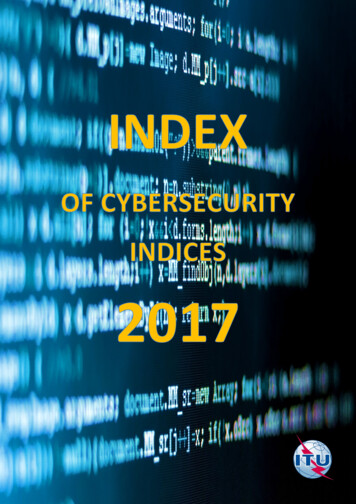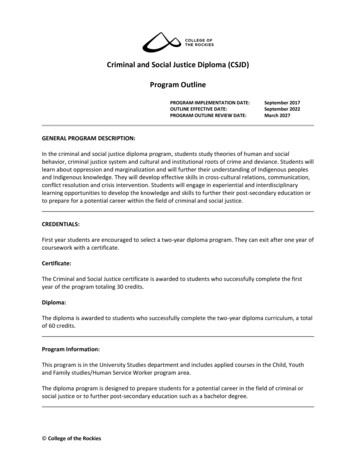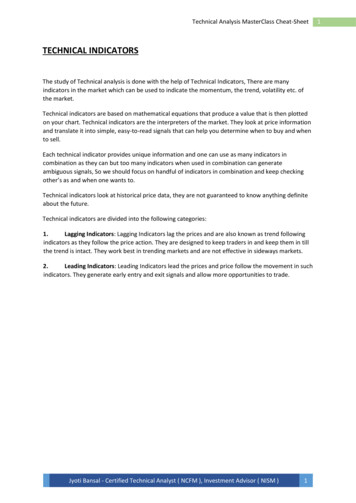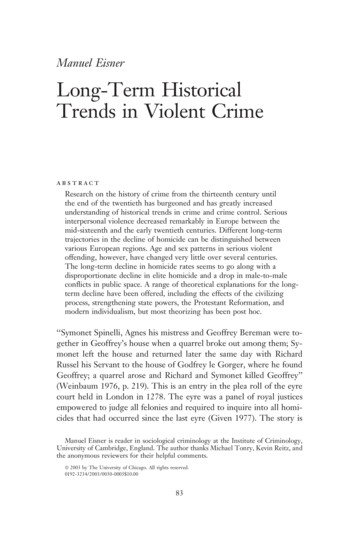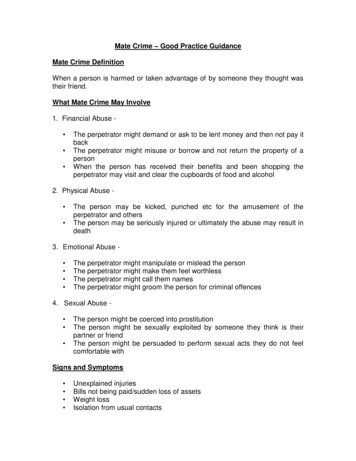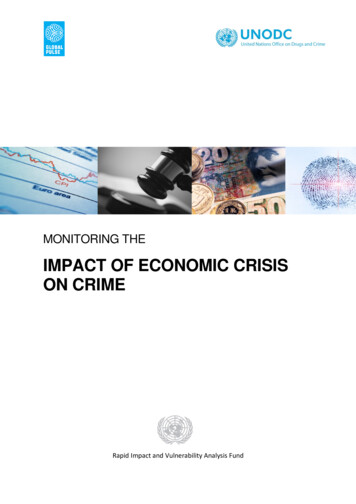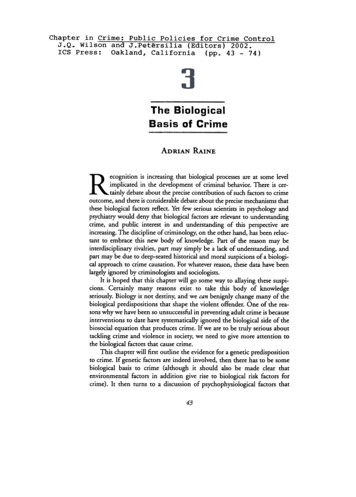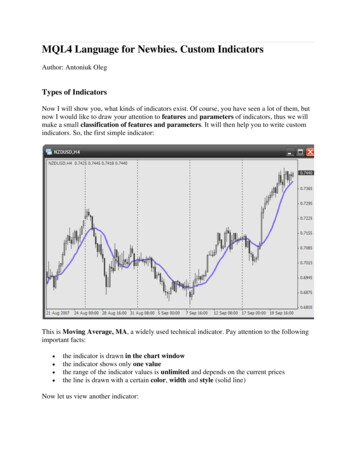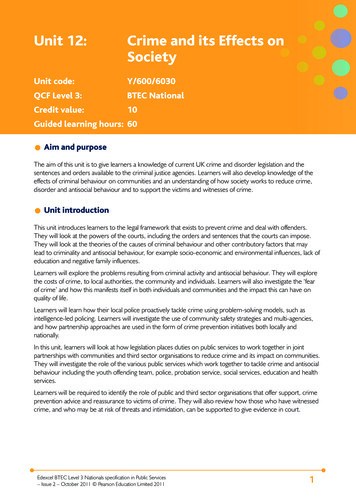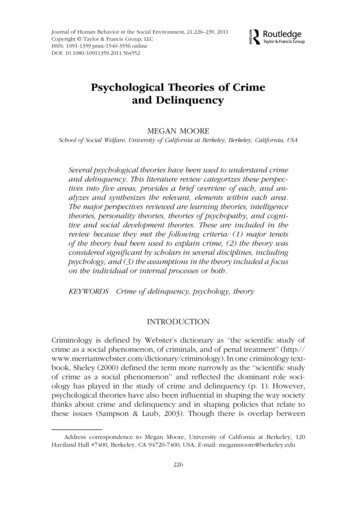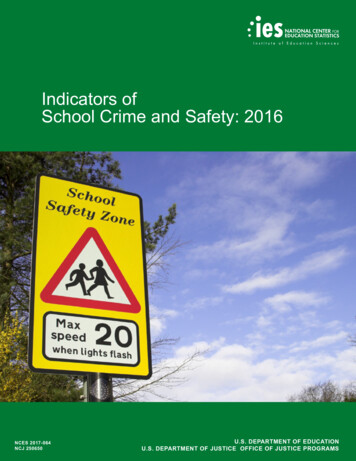
Transcription
Indicators ofSchool Crime and Safety: 2016NCES 2017-064NCJ 250650U.S. DEPARTMENT OF EDUCATIONU.S. DEPARTMENT OF JUSTICE OFFICE OF JUSTICE PROGRAMS
Indicators ofSchool Crime and Safety: 2016MAY 2017Lauren Musu-GilletteProject OfficerNational Center for Education StatisticsAnlan ZhangKe WangJizhi ZhangAmerican Institutes for ResearchBarbara A. OudekerkBureau of Justice StatisticsNCES 2017-064NCJ 250650U.S. DEPARTMENT OF EDUCATIONU.S. DEPARTMENT OF JUSTICE OFFICE OF JUSTICE PROGRAMS
U.S. Department of EducationBetsy DeVosSecretaryInstitute of Education SciencesThomas W. BrockCommissioner for Education ResearchDelegated the Duties of the DirectorNational Center for Education StatisticsPeggy G. CarrActing CommissionerBureau of Justice StatisticsJeri M. MulrowActing DirectorThe National Center for Education Statistics (NCES) is the primary federal entity for collecting, analyzing,and reporting data related to education in the United States and other nations. It fulfills a congressionalmandate to collect, collate, analyze, and report full and complete statistics on the condition of education inthe United States; conduct and publish reports and specialized analyses of the meaning and significance ofsuch statistics; assist state and local education agencies in improving their statistical systems; and review andreport on education activities in foreign countries.The Bureau of Justice Statistics (BJS) is the primary federal entity for collecting, analyzing, publishing, anddisseminating statistical information about crime, its perpetrators and victims, and the operation of thejustice system at all levels of government. It fulfills a congressional mandate to provide valid statistics on crimeand justice systems, support improvement to justice information systems, and participate with national andinternational organizations to develop and recommend national standards for justice statistics.We strive to make our products available in a variety of formats and in language that is appropriate to a varietyof audiences. You, as our customer, are the best judge of our success in communicating information effectively.If you have any comments or suggestions about this product, we would like to hear from you. Please directyour comments toNCES, IES, U.S. Department of EducationPotomac Center Plaza550 12th Street SWWashington, DC 20202May 2017This report was prepared for the National Center for Education Statistics under Contract No. ED-IES12-D-0002 with American Institutes for Research. Mention of trade names, commercial products, ororganizations does not imply endorsement by the U.S. Government.Suggested CitationMusu-Gillette, L., Zhang, A., Wang, K., Zhang, J., and Oudekerk, B.A. (2017). Indicators of School Crimeand Safety: 2016 (NCES 2017-064/NCJ 250650). National Center for Education Statistics, U.S. Departmentof Education, and Bureau of Justice Statistics, Office of Justice Programs, U.S. Department of Justice.Washington, DC.This publication is only available online. To download, view, and print the report as a PDF file, go to http://nces.ed.gov or https://bjs.gov.Contact at NCESLauren ovContact at BJSBarbara A. Oudekerk202-616-3904Barbara.A.Oudekerk@usdoj.gov
Executive SummaryIntroductionOur nation’s schools should be safe havens forteaching and learning, free of crime and violence. Anyinstance of crime or violence at school not only affectsthe individuals involved, but also may disrupt theeducational process and affect bystanders, the schoolitself, and the surrounding community (Brookmeyer,Fanti, and Henrich 2006; Goldstein, Young, andBoyd 2008).Establishing reliable indicators of the current stateof school crime and safety across the nation andregularly updating and monitoring these indicatorsare important in ensuring the safety of our nation’sstudents. This is the aim of Indicators of School Crimeand Safety.This report is the 19th in a series of annual publicationsproduced jointly by the National Center forEducation Statistics (NCES), Institute of EducationSciences (IES), in the U.S. Department of Education,and the Bureau of Justice Statistics (BJS) in the U.S.Department of Justice. This report presents the mostrecent data available on school crime and studentsafety. The indicators in this report are based oninformation drawn from a variety of data sources,including national surveys of students, teachers,principals, and postsecondary institutions. Sourcesinclude results from the School-Associated ViolentDeath Surveillance System, sponsored by the U.S.Department of Education, the Department of Justice,and the Centers for Disease Control and Prevention(CDC); the National Crime Victimization Survey andSchool Crime Supplement to that survey, sponsored byBJS and NCES, respectively; the Youth Risk BehaviorSurvey, sponsored by the CDC; the Schools andStaffing Survey, School Survey on Crime and Safety,Fast Response Survey System, EDFacts, and EarlyChildhood Longitudinal Study, Kindergarten Class of2010–11, all sponsored by NCES; the SupplementaryHomicide Reports, sponsored by the Federal Bureauof Investigation; the Campus Safety and SecuritySurvey and Civil Rights Data Collection, bothsponsored by the U.S. Department of Education; andthe Trends in International Mathematics and ScienceStudy, sponsored by the International Association forthe Evaluation of Educational Achievement. The mostrecent data collection for each indicator varied bysurvey, from 2009 to 2015. Each data source has anindependent sample design, data collection method,and questionnaire design, or is the result of a universedata collection. Findings described in this report withcomparative language (e.g., higher, lower, increase,and decrease) are statistically significant at the.05 level. Additional information about methodologyand the datasets analyzed in this report may be foundin appendix A.This report covers topics such as victimization, teacherinjury, bullying and cyber-bullying, school conditions,fights, weapons, availability and student use of drugsand alcohol, student perceptions of personal safetyat school, and criminal incidents at postsecondaryinstitutions. Indicators of crime and safety arecompared across different population subgroups andover time. Data on crimes that occur away from schoolare offered as a point of comparison where available.Key FindingsPreliminary data show that there were 48 schoolassociated violent deaths1 from July 1, 2013, throughJune 30, 2014 (Indicator 1). In 2015, among studentsages 12–18, there were about 841,100 nonfatalvictimizations (theft2 and violent victimization3) atschool4 and 545,100 nonfatal victimizations awayfrom school (Indicator 2). In 2015, about 21 percentof students ages 12–18 reported being bullied at schoolduring the school year (Indicator 11). Of the 804 totalhate crimes5 reported on college campuses in 2014, themost common type of hate crime was intimidation(343 incidents), followed by destruction, damage,and vandalism (327 incidents) and simple assault(61 incidents; Indicator 23).1A school-associated violent death is defined as a homicide, suicide,or legal intervention death (involving a law enforcement officer),in which the fatal injury occurred on the campus of a functioningelementary or secondary school in the United States, while thevictim was on the way to or from regular sessions at school, or whilethe victim was attending or traveling to or from an official schoolsponsored event. Victims include students, staff members, andothers who are not students or staff members.2“Theft” includes attempted and completed purse-snatching,completed pickpocketing, and all attempted and completed thefts,with the exception of motor vehicle thefts. Theft does not includerobbery, which involves the threat or use of force and is classified asa violent crime.3“Violent victimization” includes serious violent crimes and simpleassault.4“At school” includes inside the school building, on school property,and on the way to or from school.5A hate crime is a criminal offense that is motivated, in whole orin part, by the perpetrator’s bias against the victim(s) based on theirrace, ethnicity, religion, sexual orientation, gender, gender identity,or disability.Indicators of School Crime and Safety: 2016iii
The following key findings are drawn from each sectionof the report.xxIn 2015, a higher percentage of self-identifiedgay, lesbian, or bisexual students than of selfidentified heterosexual students reported that theyhad been bullied on school property during theprevious 12 months, overall (34 vs. 19 percent)as well as among male (26 vs. 15 percent) andfemale students (37 vs. 23 percent). Similarly,with respect to electronic bullying, a higherpercentage of gay, lesbian, or bisexual studentsreported being electronically bullied during theprevious 12 months in 2015 than did heterosexualstudents, overall (28 vs. 14 percent) as wellas among male (22 vs. 9 percent) and femalestudents (30 vs. 21 percent; Spotlight 3).xxThe percentages of students overall who reportedbeing in a physical fight anywhere and on schoolproperty during the previous 30 days werehigher for self-identified gay, lesbian, or bisexualstudents (28 and 11 percent, respectively) andstudents who were not sure about their sexualorientation (35 and 15 percent, respectively) thanfor their self-identified heterosexual peers (22 and7 percent, respectively; Spotlight 3).xxA higher percentage of self-identified gay, lesbian,or bisexual students than of self-identifiedheterosexual students reported that they hadconsumed alcohol on at least 1 day during theprevious 30 days, overall (40 vs. 32 percent)and among female students (42 vs. 32 percent).A higher percentage of gay, lesbian, or bisexualstudents than of heterosexual students alsoreported using marijuana at least one time duringthe previous 30 days, overall (32 vs. 21 percent)and among female students (34 vs. 18 percent;Spotlight 3).SpotlightsxxIn 2015, about 15 percent of U.S. fourthgraders and 7 percent of U.S. eighth-gradersreported experiencing bullying at least oncea month. These percentages were lower thanthe international averages for fourth-gradersand eighth-graders (16 percent and 8 percent,respectively; Spotlight 1).xxIn the United States, 7 percent of participatingfourth-grade students attended schools that wereless than safe and orderly, according to the datareported by their teachers. This was higher thanthe international average of 4 percent as well ashigher than the percentages in 22 countries andnot measurably different from the percentages in19 countries. About 13 percent of participatingU.S. eighth-grade students reported attendingschools that were less than safe and orderly,according to the data reported by their teachers;this was higher than the international average of8 percent. The percentage of U.S. eighth-gradestudents whose teachers reported their schoolwas less than safe and orderly was lower thanthe percentages in 2 countries, higher than thepercentages in 26 countries, and not measurablydifferent from the percentages in 7 countries(Spotlight 1).xxivAbout 3 percent of U.S. fourth-graders and2 percent of U.S. eighth-graders attendedschools with moderate to severe disciplineproblems, according to data reported by theirprincipals. These percentages were lower thanthe international averages for fourth-gradersand eighth-graders (10 percent and 11 percent,respectively; Spotlight 1).xxIn the spring of 2014, about 15 percent of thirdgraders reported that they were frequently teased,made fun of, or called names by other students;22 percent were frequently the subject of lies oruntrue stories; 14 percent were frequently pushed,shoved, slapped, hit, or kicked; and 15 percentwere frequently excluded from play on purpose(Spotlight 2).xxThird-graders who reported that they werefrequently victimized scored lower in reading,mathematics, and science than their peers whoreported that they were never victimized orthat they were sometimes or rarely victimized(Spotlight 2).Executive SummaryViolent Deathsxx6A total of 48 student, staff, and nonstudentschool-associated violent deaths occurred betweenJuly 1, 2013, and June 30, 2014, which included26 homicides, 20 suicides, 1 legal interventiondeath, 6 and 1 undetermined violent death. 7Of these 48 school-associated violent deaths,12 homicides and 8 suicides were of school-ageyouth (ages 5–18; Indicator 1).A legal intervention death is defined as a death caused by a lawenforcement agent in the course of arresting or attempting to arresta lawbreaker, suppressing a disturbance, maintaining order, orengaging in another legal action.7An undetermined violent death is a violent death for which themanner was undetermined. That is, the information pointing toone manner of death was no more compelling than one or moreother competing manners of death when all available informationwas considered.
xxxxIn 2015, about 6 percent of students in grades9–12 reported that they had been threatenedor injured with a weapon on school property9during the previous 12 months. The percentageof students who reported being threatened orinjured with a weapon on school property waslower in 2015 than in every survey year between1993 and 2011; however, there was no measurabledifference between the percentages in 2013 and2015 (Indicator 4).xxIn each survey year from 1993 to 2015, a lowerpercentage of female students than of malestudents in grades 9–12 reported being threatenedor injured with a weapon on school property inthe previous 12 months (Indicator 4).xxBetween 1992 and 2015, total victimization ratesfor students ages 12–18 generally declined bothat school and away from school. Additionally,thefts, violent victimizations, and serious violentvictimizations both at and away from school alldeclined during this period (Indicator 2).In 2015, lower percentages of Asian students(4 percent) and White students (5 percent) thanof Black students (8 percent) and Pacific Islanderstudents (20 percent) reported being threatened orinjured with a weapon on school property duringthe previous 12 months (Indicator 4).xxIn 2015, students ages 12–18 residing in ruralareas had a lower rate of total victimization atschool (18 victimizations per 1,000 students) thanstudents residing in urban areas (35 victimizationsper 1,000 students) and suburban areas(36 victimizations per 1,000 students; Indicator 2).During the 2011–12 school year, a higherpercentage of public than private school teachersreported being threatened with injury (10 vs.3 percent) or being physically attacked (6 vs.3 percent) by a student from their school(Indicator 5).xxIn 2015, approximately 3 percent of studentsages 12–18 reported being victimized at schoolduring the previous 6 months. About 2 percentof students reported theft, 1 percent reportedviolent victimization, and less than one-half of1 percent reported serious violent victimization(Indicator 3).Ten percent of elementary teachers and 9 percentof secondary teachers reported being threatenedby a student from their school in 2011–12. Thepercentage of elementary teachers who reportedbeing physically attacked by a student was higherthan the percentage of secondary teachers (8 vs.3 percent; Indicator 5).School EnvironmentBetween July 1, 2013 and June 30, 2014, a totalof 12 of the 1,053 homicides of school-age youthoccurred at school.8 During the same period,there were 8 suicides of school-age youth atschool, compared with 1,645 total suicides ofschool-age youth that occurred in calendar year2013 (Indicator 1).Nonfatal Student and Teacher VictimizationxxxxxxxxxxIn 2015, students ages 12–18 experienced841,100 nonfatal victimizations (theft andviolent victimization) at school and 545,100nonfatal victimizations away from school. Thesefigures represent total crime victimization ratesof 33 victimizations per 1,000 students at schooland 21 per 1,000 students away from school(Indicator 2).Between 1995 and 2015, the percentage ofstudents ages 12–18 who reported being victimizedat school during the previous 6 months decreasedoverall (from 10 to 3 percent). During this period,the percentage of students who reported beingvictimized at school also decreased for bothmale (from 10 to 3 percent) and female students(from 9 to 3 percent), as well as for White (from10 to 3 percent), Black (from 10 to 2 percent),and Hispanic students (from 8 to 2 percent;Indicator 3).8This finding is drawn from the School-Associated ViolentDeath Surveillance System, which defines “at school” for surveyrespondents as on school property, on the way to or from regularsessions at school, and while attending or traveling to or from aschool-sponsored event.xxDuring the 2013–14 school year, 65 percent ofpublic schools recorded that one or more incidentsof violence had taken place, amounting to anestimated 757,000 crimes. This figure translatesto a rate of approximately 15 crimes per 1,000students enrolled in 2013–14 (Indicator 6).xxIn 2013–14, about 58 percent of public schoolsrecorded one or more incidents of a physicalattack or fight without a weapon, 47 percent ofschools recorded one or more incidents of threat ofphysical attack without a weapon, and 13 percentof public schools recorded one or more seriousviolent incidents (Indicator 6).9“On school property” was not defined for survey respondents inthe Youth Risk Behavior Survey.Indicators of School Crime and Safety: 2016v
xxPrimary schools recorded lower percentages ofviolent incidents in 2013–14 (53 percent ofschools) than middle schools (88 percent) andhigh schools and combined elementary/secondaryschools (referred to as high/combined schools)(78 percent; Indicator 6).xxIn 2015, lower percentages of Asian students(15 percent), White students (20 percent), andBlack students (21 percent) than of Hispanicstudents (27 percent) reported that illegal drugswere made available to them on school property(Indicator 9).xxThe percentage of public schools that reportedstudent bullying occurred at least once a weekdecreased from 29 percent in 1999–2000 to16 percent in 2013–14. Similarly, the percentageof schools that reported the occurrence ofstudent verbal abuse of teachers decreased from13 percent in 1999–2000 to 5 percent in 2013–14(Indicator 7).xxxxThe percentage of public schools reportingstudent harassment of other students based onsexual orientation or gender identity was lower in2013–14 (1 percent) than in 2009–10 (3 percent;Indicator 7).During the 2014–15 school year, the rate ofillicit drug-related discipline incidents was 389per 100,000 students in the United States. Themajority of jurisdictions had rates between 100and 1,000 illicit drug-related discipline incidentsper 100,000 students during the 2014–15 schoolyear. Three states had rates of illicit drug-relateddiscipline incidents per 100,000 students thatwere below 100: Wyoming, Texas, and Michigan,while Kentucky had the only rate that was above1,000 (Indicator 9).xxThe percentage of students ages 12–18 whoreported being the target of hate-related wordsat school during the school year decreased from12 percent in 2001 (the first year of data collectionfor this item) to 7 percent in 2015 (Indicator 10).xxThe percentage of students ages 12–18 whoreported seeing hate-related graffiti at schoolduring the school year decreased from 36 percentin 1999 (the first year of data collection for thisitem) to 27 percent in 2015 (Indicator 10).xxIn 2015, lower percentages of White (6 percent)and Hispanic (7 percent) students than of Black(9 percent) students and students of other racial/ethnic groups (11 percent) reported being called ahate-related word at school during the school year.Also in 2015, a lower percentage of Asian studentsthan students of any other race/ethnicity reportedseeing hate-related graffiti at school during theschool year (Indicator 10).xxIn 2015, about 21 percent of students ages 12–18reported being bullied at school during the schoolyear. A higher percentage of female than of malestudents reported being bullied at school duringthe school year (23 vs. 19 percent; Indicator 11).xxIn 2015, about 33 percent of students whoreported being bullied at school indicatedthat they were bullied at least once or twice amonth during the school year. The percentage ofstudents who reported notifying an adult afterbeing bullied at school was higher for those whoreported being bullied once or twice a week thanfor those who reported being bullied once or twicea year (63 vs. 37 percent; Indicator 11).xxxxBetween 2001 and 2015, the percentage ofstudents ages 12–18 who reported that gangswere present at their school decreased from 20 to11 percent. The percentage who reported gangswere present at their school was also lower in 2015than in 2013 (12 percent; Indicator 8).xxA higher percentage of students from urban areas(15 percent) reported a gang presence than ofstudents from suburban (10 percent) and ruralareas (4 percent) in 2015. Additionally, a higherpercentage of students attending public schools(11 percent) than of students attending privateschools (2 percent) reported that gangs werepresent at their school in 2015 (Indicator 8).xxxxviDuring the 2013–14 school year, the percentageof public schools that reported student bullyingoccurred at least once a week was higher formiddle schools (25 percent) than high schools/combined schools (17 percent), and percentagesfor both of these school levels were higher thanthe percentage of primary schools (12 percent;Indicator 7).In 2015, higher percentages of Black (17 percent)and Hispanic (15 percent) students reported thepresence of gangs at their school than of White(7 percent) and Asian (4 percent) students(Indicator 8).The percentage of students in grades 9–12 whoreported that illegal drugs were made availableto them on school property decreased from32 percent in 1995 to 22 percent in 2015(Indicator 9).Executive Summary
xxxxxxxxxxOf students who reported being bullied at schoolduring the school year in 2015, about 19 percentreported that bullying had somewhat or a lot ofnegative effect on how they felt about themselves,14 percent each reported that bullying hadsomewhat or a lot of negative effect on theirrelationships with friends or family and on theirschool work, and 9 percent reported that bullyinghad somewhat or a lot of negative effect on theirphysical health (Indicator 11).Between 2005 and 2015, the percentage ofstudents reporting being bullied at school duringthe school year decreased from 28 to 21 percent.During this period, the percentage of students whoreported being bullied at school also decreased forstudents in suburban and rural areas as well as forthose in public schools. There was no significantpattern of change for those students in urbanareas and those in private schools (Indicator 11).In 2011–12, about 38 percent of teachers agreedor strongly agreed that student misbehaviorinterfered with their teaching, and 35 percentreported that student tardiness and class cuttinginterfered with their teaching. Sixty-nine percentof teachers agreed or strongly agreed that otherteachers at their school enforced the schoolrules, and 84 percent reported that the principalenforced the school rules (Indicator 12).The percentage of teachers who reported thatstudent misbehavior interfered with their teachingfluctuated between 1993–94 and 2011–12;however, the percentage of teachers reportingthat student tardiness and class cutting interferedwith their teaching increased over this time period(from 25 to 35 percent). Between 1993–94 and2011–12, the percentage of teachers who reportedthat school rules were enforced by other teachersfluctuated between 64 and 73 percent, and thepercentage who reported that rules were enforcedby the principal fluctuated between 82 and89 percent (Indicator 12).A higher percentage of public school teachers(41 percent) than of private school teachers(22 percent) reported that student misbehaviorinterfered with their teaching in 2011–12. Inaddition, 38 percent of public school teachersreported that student tardiness and class cuttinginterfered with their teaching, compared with19 percent of private school teachers. Duringthe same year, lower percentages of public schoolteachers than of private school teachers agreedthat school rules were enforced by other teachers(68 vs. 77 percent) and by the principal in theirschool (84 vs. 89 percent; Indicator 12).Fights, Weapons, and Illegal SubstancesxxThe percentage of students in grades 9–12 whoreported being in a physical fight anywheredecreased between 1993 and 2015 (from 42 to23 percent), and the percentage who reportedbeing in a physical fight on school propertyalso decreased during this period (from 16 to8 percent; Indicator 13).xxIn 2015, a higher percentage of 9th-gradersthan of 10th-, 11th-, and 12th-graders reportedbeing in a physical fight, either anywhere or onschool property, during the previous 12 months(Indicator 13).xxA higher percentage of male than of female9th- to 12th-graders reported being in a physicalfight anywhere (28 vs. 16 percent) and on schoolproperty (10 vs. 5 percent) during the previous12 months in 2015 (Indicator 13).xxA higher percentage of Black students (32 percent)reported being in a physical fight anywhereduring the previous 12 months in 2015 than didHispanic students (23 percent), White students(20 percent), and Asian students (15 percent).Higher percentages of Black students (13 percent)and Hispanic students (9 percent) reported beingin a physical fight on school property in 2015than did White students (6 percent; Indicator 13).xxThe percentage of students in grades 9–12 whoreported carrying a weapon anywhere during theprevious 30 days decreased from 22 percent in1993 to 16 percent in 2015, and the percentageof students who reported carrying a weapon onschool property during the previous 30 daysdecreased from 12 percent in 1993 to 4 percentin 2015 (Indicator 14).xxIn every survey year from 1993 to 2015, a higherpercentage of male students than of femalestudents reported that they had carried a weapon,both anywhere and on school property, during theprevious 30 days (Indicator 14).xxDuring the 2014–15 school year, there were 1,500reported firearm possession incidents at schoolsin the United States, and the rate of firearmpossession incidents was 3 per 100,000 students.Two states had rates above 10: Missouri andArkansas (Indicator 14).Indicators of School Crime and Safety: 2016vii
xxxxxxxxxxviiiThe percentage of students ages 12–18 whoreported that they had access to a loaded gunwithout adult permission, either at school oraway from school, during the current school yeardecreased from 7 percent in 2007 to 4 percent in2015 (Indicator 14).The percentage of students in grades 9–12 whoreported consuming alcohol on at least 1 dayduring the previous 30 days decreased from 48 to33 percent between 1993 and 2015 (Indicator 15).In 2015, higher percentages of American Indian/Alaska Native students (46 percent), students ofTwo or more races (40 percent), White students(35 percent), and Hispanic students (34 percent)than of Black students (24 percent) and Asianstudents (13 percent) reported consuming alcoholon at least 1 day during the previous 30 days(Indicator 15).During the 2014–15 school year, the rate ofalcohol-related discipline incidents was 45 per100,000 students in the United States. Themajority of jurisdictions had rates between 10 and100 alcohol-related discipline incidents per100,000 students during the 2014–15 school year.Two states had rates of alcohol-related disciplineincidents per 100,000 students that were below10: Texas and Wyoming, while six states had ratesabove 100: Arkansas, Alaska, Missouri, Indiana,Kentucky, and Colorado (Indicator 15).In 2015, some 22 percent of students in grades9–12 reported using marijuana at least one timeduring the previous 30 days, which was higherthan the percentage reported in 1993 (18 percent)but not measurably different from that reportedin 2013 (Indicator 16).xxIn every survey year between 1993 and 2011,higher percentages of male students than offemale students reported using marijuana at leastone time during the previous 30 days; in 2013and 2015, however, there were no measurabledifferences in the percentages reported by maleand female students (Indicator 16).xxThe percentage of Asian students (8 percent) whoreported using marijuana at least one time duringthe previous 30 days was lower than the percentagesreported by White students (20 percent), studentsof Two or more races (23 percent), Hispanicstudents (24 percent), American Indian/AlaskaNative students (27 percent), and Black students(27 percent). The percentage for White studentswas also lower than the percentages for Hispanicand Black students (Indicator 16).Executive SummaryFear and AvoidancexxThe percentage of students who reported beingafraid of attack or harm at school decreased from12 percent in 1995 to 3 percent in 2015, and thepercentage of students who reported being afraidof attack or harm away from school decreasedfrom 6 percent in 1999 to 2 percent in 2015(Indicator 17).xxIn 2015, a higher percentage of female studentsthan of male students, as well as a higherpercentage of Hispanic students than of Whitestudents, reported being afraid of attack or harmat school and away from school. Additionally,higher percentages of students in urban andsuburban areas than of students in rural areasreported being afraid of attack or harm away fromschool (Indicator 17).xxIn 2015, about 5 percent of students ages 12–18reported that they avoided at least one schoolactivity or class10 or one or more places in school11during the previous school year because theythought someone might attack or harm them(Indicator 18).xxHigher percentages of students in urban (5 percent)and suburban areas (4 percent) reported avoidingone or more places in school than did studentsin rural areas (2 percent) in 2015. In addition, ahigher percentage of public school studen
In 2015, about 15 percent of U.S. fourth-graders and 7 percent of U.S. eighth-graders reported experiencing bullying at least once a month. These percentages were lower than the international averages for fourth-graders and eighth-graders (16 percent and 8 percent, respectively; Spotlight 1). x In the United States, 7 percent of participating
